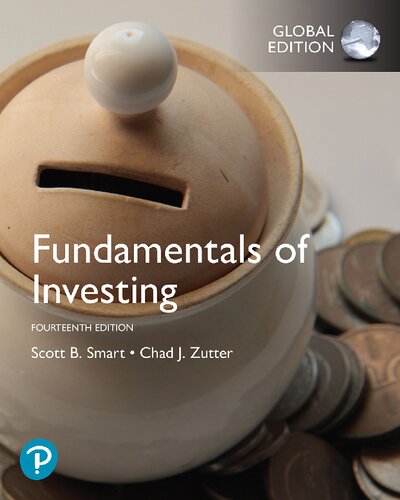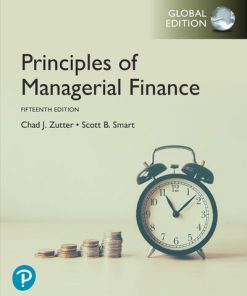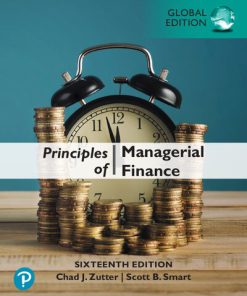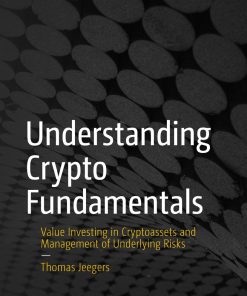Fundamentals of Investing 14th editon by Scott Smart, Chad Zutter 013489779X 9780134897790
$50.00 Original price was: $50.00.$25.00Current price is: $25.00.
Fundamentals of Investing 14th editon by Scott Smart, Chad Zutter – Ebook PDF Instant Download/Delivery: 013489779X, 9780134897790
Full download Fundamentals of Investing 14th editon after payment

Product details:
ISBN 10: 013489779X
ISBN 13: 9780134897790
Author: Scott B. Smart; Chad J. Zutter
For undergraduate investment courses. The core concepts and tools students need to make informed investment decisions Fundamentals of Investing uses practical, hands-on applications and examples to introduce the topics and techniques used by both personal investors and money managers. The text focuses on both individual securities and portfolios, teaching students to consider the risk and return of different types of investments and how to use this knowledge to achieve financial goals. A consistent framework centered around learning objectives keeps readers focused in each chapter while a conversational tone makes the language, concepts, and strategies accessible to students. With new topics and features added to the 14th Edition, the text remains up-to-date and relevant, so students leave the course equipped to develop, implement, and monitor a successful investment program.
Fundamentals of Investing 14th Table of contents:
Part One Preparing to Invest
1 The Investment Environment
Learning Goals
Investments and the Investment Process
Attributes of Investments
Securities or Property
Direct or Indirect
Debt, Equity, or Derivative Securities
Low- or High-Risk Investments
Short- or Long-Term Investments
Domestic or Foreign
The Structure of the Investment Process
Types of Investments
Short-Term Investments
Common Stock
Fixed-Income Securities
Bonds
Convertible Securities
Preferred Stock
Mutual Funds
Exchange-Traded Funds
Hedge Funds
Derivative Securities
Options
Futures
Other Popular Investments
Making Your Investment Plan
Writing an Investment Policy Statement
Summarize your current situation
Specify your investment goals
Articulate your investment philosophy
Set investment selection guidelines
Assign responsibility for selecting and monitoring investments
Considering Personal Taxes
Basic Sources of Taxation
Types of Income
Ordinary Income
Capital Gains and Losses
Investments and Taxes
Tax-Advantaged Retirement Savings Plans
Investing over the Life Cycle
Investing over the Business Cycle
Meeting Liquidity Needs with Short-Term Investments
The Role of Short-Term Investments
Interest on Short-Term Investments
Risk Characteristics
Advantages and Disadvantages of Short-Term Investments
Common Short-Term Investments
Investment Suitability
Careers in Finance
Developing Skills for Your Career
Critical Thinking
Communication and Collaboration
Financial Computing Skills
Discussion Questions
Problems
Case Problem 1.1 Investments or Golf?
Case Problem 1.2 Preparing Susan Bowen’s Investment Plan
2 Securities Markets and Transactions
Learning Goals
Securities Markets
Types of Securities Markets
The Primary Market
Public Offerings: The IPO Process
Public Offerings: The Investment Bank’s Role
Public Offerings: The Direct Listing Process
The Secondary Market
Broker Markets and Dealer Markets
Broker Markets
The New York Stock Exchange
Trading Activity
Listing Policies
Options Exchanges
Futures Exchanges
Dealer Markets
Nasdaq Stock Market
The Over-the-Counter Market
Electronic and High-Frequency Trading
Electronic Communications Networks
High-Frequency Trading
General Market Conditions: Bull or Bear
Globalization of Securities Markets
Growing Importance of International Markets
International Investment Performance
Ways to Invest in Foreign Securities
Risks of Investing Internationally
Trading Hours and Regulation of Securities Markets
Trading Hours of Securities Markets
Regulation of Securities Markets
Basic Types of Securities Transactions
Long Purchase
Margin Trading
Essentials of Margin Trading
Magnified Profits and Losses
Advantages and Disadvantages of Margin Trading
Making Margin Transactions
Initial Margin
Maintenance Margin
The Basic Margin Formula
Return on Invested Capital
Uses of Margin Trading
Short Selling
Essentials of Short Selling
Making Money When Prices Fall
Who Lends the Securities?
Margin Requirements and Short Selling
Advantages and Disadvantages
Uses of Short Selling
Discussion Questions
Problems
Case Problem 2.1 Darren’s Dilemma: What to Buy?
Case Problem 2.2 Ravi Dumar’s High-Flying Margin Account
3 Investment Informationand Securities Transactions
Learning Goals
Investment Research and Planning
Getting Started in Investment Research
Investment Education Sites
Investment Tools
Planning
Screening
Charting
Stock Quotes and Portfolio Tracking
A Word of Caution About Internet Trading
Types and Sources of Investment Information
Types of Information
Sources of Information
Economic and Current Event Information
Financial Journals
Institutional News
Business Periodicals
Government Publications
Special Subscription Services
Industry and Company Information
Fair Disclosure Rules
Stockholders’ Reports
Comparative Data Sources
Subscription Services
Brokerage Reports
Investment Letters
Price Information
Other Online Investment Information Sources
Bond Sites
Mutual Fund Sites
International Sites
Investment Discussion Forums
Avoiding Scams
Understanding Market Averages and Indexes
Stock Market Averages and Indexes
The Dow Jones Averages
Standard & Poor’s Indexes
NYSE, NYSE MKT, and Nasdaq Indexes
Value Line Indexes
Other Averages and Indexes
Bond Market Indicators
Bond Yields
Bond Indexes
Making Securities Transactions
The Role of Stockbrokers
Brokerage Services
Types of Brokerage Firms
Selecting a Stockbroker
Opening an Account
Single or Joint
Cash or Margin
Wrap
Odd-Lot and Round-Lot Transactions
Basic Types of Orders
Market Order
Limit Order
Stop-Loss Order
Online Transactions
Day Trading
Technical and Service Problems
Tips for Successful Online Trades
Transaction Costs
Investor Protection: SIPC and Arbitration
Investment Advisors and Investment Clubs
Using an Investment Advisor
Regulation of Advisors
Robo-Advisors
The Cost and Use of Investment Advice
Investment Clubs
Discussion Questions
Problems
Case Problem 3.1 Emily’s Good Fortune
Case Problem 3.2 Donald and Laurie’s Choices of Brokers and Advisors
Part Two Important Conceptual Tools
4 Return and Risk
Learning Goals
The Concept of Return
Components of Return
Income
Capital Gains (or Losses)
Why Return is Important
Historical Performance
Expected Return
Level of Return
Internal Characteristics
External Forces
Historical Returns
The Time Value of Money and Returns
Measuring Return
Real, Risk-Free, and Required Returns
Inflation and Returns
Risk and Returns
Holding Period Return
Understanding Return Components
Computing the Holding Period Return
Using the HPR in Investment Decisions
The Internal Rate of Return
IRR for a Single Cash Flow
Calculator Use
Spreadsheet Use
IRR for a Stream of Income
Calculator Use
Spreadsheet Use
Finding Growth Rates
Calculator Use
Spreadsheet Use
Risk: The Other Side of the Coin
Sources of Risk
Business Risk
Financial Risk
Purchasing Power Risk
Interest Rate Risk
Liquidity Risk
Tax Risk
Event Risk
Market Risk
Risk of a Single Asset
Standard Deviation: A Measure of Return Volatility
Historical Returns and Risk
Assessing Risk
Risk-Return Characteristics of Alternative Investments
An Acceptable Level of Risk
Steps in the Decision Process: Combining Return and Risk
Discussion Questions
Problems
Case Problem 4.1 Coates’s Decision
Case Problem 4.2 The Risk-Return Tradeoff: Molly O’Rourke’s Stock Purchase Decision
Questions
Chapter-Opening Problem
4A Appendix The Time Value of Money
Interest: The Basic Return to Savers
Simple Interest
Compound Interest
Computational Aids for Use in Time Value Calculations
Financial Calculators
Computers and Spreadsheets
Future Value: An Extension of Compounding
Future Value of an Annuity
Present Value: An Extension of Future Value
Present Value of a Stream of Returns
Present Value of a Mixed Stream
Present Value of an Annuity
Problems
5 Modern Portfolio Concepts
Learning Goals
Principles of Portfolio Planning
Portfolio Objectives
Portfolio Return and Standard Deviation
Correlation and Diversification
Correlation
Diversification
international Diversification
Effectiveness of International Diversification
Methods of International Diversification
Costs of International Diversification
The Capital Asset Pricing Model
Components of Risk
Beta: A Measure of Undiversifiable Risk
Estimating Beta
Interpreting Beta
Applying Beta
The CAPM: The Connection Between Beta and Expected Return
The Equation
The Security Market Line
Some Closing Comments
Traditional Versus Modern Portfolio Management
The Traditional Approach
Modern Portfolio Theory
The Efficient Frontier
Portfolio Betas
Risk Diversification
Calculating Portfolio Betas
Interpreting Portfolio Betas
Reconciling the Traditional Approach and MPT
Discussion Questions
Problems
Case Problem 5.1 Traditional Versus Modern Portfolio Theory: Who’s Right?
Case Problem 5.2 Susan Lussier’s Inherited Portfolio: Does It Meet Her Needs?
Chapter-Opening Problem
Questions
CFA Exam Questions
The Investment Environment and Conceptual Tools
Part Three Investing in Common Stocks
6 Common Stocks
Learning Goals
What Stocks Have to Offer
The Appeal of Common Stocks
Putting Stock Price Behavior in Perspective
A Real Estate Bubble Goes Bust and So Does the Market
The Pros and Cons of Stock Ownership
The Advantages of Stock Ownership
The Disadvantages of Stock Ownership
Basic Characteristics of Common Stock
Common Stock as a Corporate Security
Issuing New Shares
Stock Spin-Offs
Stock Splits
Treasury Stock
Classified Common Stock
Buying and Selling Stocks
Reading the Quotes
Transaction Costs
Common Stock Values
Par Value
Book Value
Market Value
Investment Value
Common Stock Dividends
The Dividend Decision
Corporate Versus Market Factors
Some Important Dates
Types of Dividends
Cash Dividends
Stock Dividends
Dividend Reinvestment Plans
Types and Uses of Common Stock
Types of Stocks
Blue-Chip Stocks
Income Stocks
Growth Stocks
Tech Stocks
Speculative Stocks
Cyclical Stocks
Defensive Stocks
Market-Cap Stocks
Investing in Foreign Stocks
Comparative Returns
Going Global: Direct Investments
Going Global with ADRs
Putting Global Returns in Perspective
Measuring Global Returns
Currency Exchange Rates
Alternative Investment Strategies
Buy-and-Hold
Current Income
Quality Long-Term Growth
Aggressive Stock Management
Speculation and Short-Term Trading
Discussion Questions
Problems
Case Problem 6.1 Sara Decides to Take the Plunge
Case Problem 6.2 Wally Wonders Whether There’s a Place for Dividends
7 Analyzing Common Stocks
Learning Goals
Security Analysis
Principles of Security Analysis
The Top-Down Approach to Security Analysis
Who Needs Security Analysis in an Efficient Market?
Economic Analysis
Economic Analysis and the Business Cycle
Key Economic Factors
Developing an Economic Outlook
Assessing the Potential Impact on Share Prices
The Market as a Leading Indicator
Industry Analysis
Key Issues
The Industry Growth Cycle
Developing an Industry Outlook
Fundamental Analysis
The Concept
Financial Statements
The Balance Sheet
The Income Statement
The Statement of Cash Flows
Financial Ratios
What Ratios Have to Offer
Liquidity Ratios
Current Ratio
Quick Ratio
Net Working Capital
Activity Ratios
Accounts Receivable Turnover
Inventory Turnover
Total Asset Turnover
Leverage Ratios
Debt-Equity Ratio
Equity Multiplier
Times Interest Earned
Profitability Ratios
Net Profit Margin
Return on Assets
Return on Equity
Breaking Down ROA and ROE
Going from ROA to ROE
An Expanded ROE Equation
Common-Stock Ratios
Price-to-Earnings Ratio
Dividends per Share
Payout Ratio
Book Value per Share
Interpreting the Numbers
Using Historical and Industry Standards
Looking at the Competition
Discussion Questions
Problems
Case Problem 7.1 Some Financial Ratios Are Real Eye-Openers
Case Problem 7.2 Anna Looks at an Auto Issue
Chapter-Opening Problem
8 Stock Valuation
Learning Goals
Valuation: Obtaining a Standard of Performance
Valuing a Company Based on Its Future Performance
Forecasted Sales and Profits
Forecasted Dividends and Prices
Estimating the P/E Ratio
A Relative Price-to-Earnings Multiple
Estimating Earnings per Share
Pulling It All Together
Developing a Forecast of Universal’s Financial Performance
The Valuation Process
Required Return
Stock Valuation Models
The Dividend Valuation Model
Zero Growth
Constant Growth
Estimating the Dividend Growth Rate
Stock-Price Behavior over Time
Variable Growth
Applying the Variable-Growth DVM
Defining the Expected Growth Rate
Other Approaches to Stock Valuation
Free Cash Flow to Equity
Zero Growth in Free Cash Flow
Constant Growth in Free Cash Flow
Variable Growth in Free Cash Flow
Using IRR to Solve for the Expected Return
The Price-to-Earnings (P/E) Approach
Other Price-Relative Procedures
A Price-to-Cash-Flow (P/CF) Procedure
Price-to-Sales (P/S) and Price-to-Book-Value (P/BV) Ratios
Discussion Questions
Problems
Case Problem 8.1 Chris Looks for a Way to Invest His Wealth
Case Problem 8.2 An Analysis of a High-Flying Stock
Chapter-Opening Problem
9 Market Efficiency and Behavioral Finance
Learning Goals
Efficient Markets
The Efficient Markets Hypothesis
Weak Form
Semi-Strong Form
Strong Form
Arbitrage and Efficient Markets
Market Anomalies
Calendar Effects
Small-Firm Effect
Post–Earnings Announcement Drift (or Momentum)
The Value Effect
Possible Explanations
Behavioral Finance: A Challenge to the Efficient Markets Hypothesis
Investor Behavior and Security Prices
Overconfidence and Self-Attribution Bias
Loss Aversion
Representativeness
Overreaction
Underreaction
Narrow Framing
Belief Perseverance
Anchoring
Familiarity Bias
Implications of Behavioral Finance for Security Analysis
Technical Analysis
Measuring the Market
The Confidence Index
Market Volume
Breadth of the Market
Short Interest
Odd-Lot Trading
Trading Rules and Measures
Advance-Decline Line
New Highs–New Lows
The Arms Index
Mutual Fund Cash Ratio
On-Balance Volume
Relative Strength
Charting
Chart Formations
Moving Averages
Discussion Questions
Problems
Case Problem 9.1 Brett Runs Some Technical Measures on a Stock
Case Problem 9.2 Deb Takes Measure of the Market
CFA Exam Questions
Investing in Common Stocks
Answers:
Part Four Investing in Fixed-Income Securities
10 Fixed-Income Securities
Learning Goals
Why Invest in Bonds?
A Brief History of Bond Prices, Returns, and Interest Rates
Historical Returns
Bonds Versus Stocks
Exposure to Risk
Essential Features of a Bond
Bond Interest and Principal
Maturity Date
Principles of Bond Price Behavior
Quoting Bond Prices
The Call Feature
Sinking Funds
Secured or Unsecured Debt
Bond Ratings
How Ratings Work
What Ratings Mean
The Market for Debt Securities
Major Market Segments
Treasury Bonds
Inflation-Protected Securities
Agency Bonds
Municipal Bonds
Tax Advantages
Taxable Equivalent Yields
Corporate Bonds
Specialty Issues
Zero-Coupon Bonds
Mortgage-Backed Securities
Collateralized Mortgage Obligations
Asset-Backed Securities
Junk Bonds
A Global View of the Bond Market
U.S.-Pay Versus Foreign-Pay Bonds
Dollar-Denominated Bonds
Foreign-Pay Bonds
Convertible Securities
Convertibles as Investment Outlets
Convertible Notes and Bonds
Conversion Privilege
LYONs
Sources of Value
Measuring the Value of a Convertible
Conversion Value
Conversion Premium
Payback Period
Investment Value
Calculator Use
Discussion Questions
Problems
Case Problem 10.1 Max and Veronica Develop a Bond Investment Program
Case Problem 10.2 The Case of the Missing Bond Ratings
Chapter-Opening Problem
11 Bond Valuation
Learning Goals
The Behavior of Market Interest Rates
Keeping Tabs on Market Interest Rates
What Causes Rates to Move?
The Term Structure of Interest Rates and Yield Curves
Types of Yield Curves
Plotting Your Own Curves
Explanations of the Term Structure of Interest Rates
Expectations Hypothesis
Liquidity Preference Theory
Market Segmentation Theory
Which Theory Is Right?
Using the Yield Curve in Investment Decisions
The Pricing of Bonds
The Basic Bond Valuation Model
Annual Compounding
Calculator Use
Spreadsheet Use
Semiannual Compounding
Calculator Use
Spreadsheet Use
Accrued Interest
Measures of Yield and Return
Current Yield
Yield to Maturity
Using Annual Compounding
Calculator Use
Spreadsheet Use
Using Semiannual Compounding
Calculator Use
Spreadsheet Use
Finding the Yield on a Zero
Calculator Use
Spreadsheet Use
Yield to Call
Calculator Use
Spreadsheet Use
Expected Return
Calculator Use
Spreadsheet Use
Valuing a Bond
Duration and Immunization
The Concept of Duration
Measuring Duration
Duration for a Single Bond
Spreadsheet Use
Duration for a Portfolio of Bonds
Bond Duration and Price Volatility
Effective Duration
Uses of Bond Duration Measures
Bond Immunization
Bond Investment Strategies
Passive Strategies
Trading on Interest Rate Forecasts
Bond Swaps
Discussion Questions
Problems
Case Problem 11.1 The Bond Investment Decisions of Dave and Marlene Carter
Case Problem 11.2 Grace Decides to Immunize Her Portfolio
CFA Exam QuestionsInvesting in Fixed-Income Securities
Answers:
Part Five Portfolio Management
12 Mutual Funds and Exchange-Traded Funds
Learning Goals
The Mutual Fund Concept
An Overview of Mutual Funds
Pooled Diversification
Active Versus Passive Management
Attractions and Drawbacks of Mutual Fund Ownership
Performance of Mutual Funds
How Mutual Funds Operate
Open- or Closed-End Funds
Closed-End Mutual Funds
Exchange-Traded Funds
Some Important Considerations
Load and No-Load Funds
Other Fees and Costs
Other Types of Investment Companies
Real Estate Investment Trusts
Hedge Funds
Types of Funds and Services
Types of Mutual Funds
Growth Funds
Aggressive-Growth Funds
Value Funds
Equity-Income Funds
Balanced Funds
Growth-and-Income Funds
Bond Funds
Money Market Funds
Index Funds
Sector Funds
Socially Responsible Funds
Asset Allocation Funds
International Funds
Investor Services
Automatic Investment Plans
Automatic Reinvestment Plans
Regular Income
Conversion Privileges
Retirement Programs
Investing in Mutual Funds
Investor Uses of Mutual Funds
Accumulation of Wealth
Storehouse of Value
Speculation and Short-Term Trading
The Selection Process
Objectives and Motives for Using Funds
What the Funds Offer
Whittling Down the Alternatives
Stick with No-Loads or Low-Loads
Investing in Closed-End Funds
Some Key Differences Between Closed-End and Open-End Funds
What to Look For in a Closed-End Fund
Measuring Performance
Sources of Return
Measures of Return
HPR with Reinvested Dividends and Capital Gains
Measuring Long-Term Returns
Returns on Closed-End Funds
The Matter of Risk
Discussion Questions
Problems
Case Problem 12.1 Reverend Mark Thomas Ponders Mutual Funds
Case Problem 12.2 Calvin Jacobs Seeks the Good Life
Chapter-Opening Problem
13 Managing Your Own Portfolio
Learning Goals
Constructing a Portfolio Using an Asset Allocation Scheme
Investor Characteristics and Objectives
Portfolio Objectives and Policies
Developing an Asset Allocation Scheme
Approaches to Asset Allocation
Fixed Weightings
Flexible Weightings
Tactical Asset Allocation
Asset Allocation Alternatives
Applying Asset Allocation
Evaluating the Performance of Individual Investments
Obtaining Data
Return Data
Economic and Market Activity
Indexes of Investment Performance
Measuring the Performance of Investments
Stocks and Bonds
Stocks
Bonds
Mutual Funds
Options and Futures
Comparing Performance to Investment Goals
Balancing Risk and Return
Isolating Problem Investments
Assessing Portfolio Performance
Measuring Portfolio Return
Measuring the Amount Invested
Measuring Income
Measuring Capital Gains
Measuring the Portfolio’s Holding Period Return
Comparison of Return with Overall Market Measures
Sharpe’s Measure
Treynor’s Measure
Jensen’s Measure (Jensen’s Alpha)
Portfolio Revision
Timing Transactions
Formula Plans
Dollar-Cost Averaging
Constant-Dollar Plan
Constant-Ratio Plan
Variable-Ratio Plan
Using Limit and Stop-Loss Orders
Limit Orders
Stop-Loss Orders
Warehousing Liquidity
Timing Investment Sales
Tax Consequences
Achieving Investment Goals
Discussion Questions
Problems
Case Problem 13.1 Assessing the Stalchecks’ Portfolio Performance
Case Problem 13.2 Evaluating Formula Plans: Charles Spurge’s Approach
CFA Exam Questions
Portfolio Management
Answers:
Part Six Derivative Securities
14 Options: Putsand Calls
Learning Goals
Call and Put Options
Basic Features of Calls and Puts
The Option Contract
Seller versus Buyer
How Calls and Puts Work
Advantages and Disadvantages
Options Markets
Conventional Options
Listed Options
Stock Options
Stock Option Provisions
Strike Price
Expiration Date
Put and Call Transactions
Options Pricing and Trading
The Profit Potential from Puts and Calls
Intrinsic Value
In the Money/Out of the Money
Put-Call Parity
What Drives Option Prices?
Time Value and Time to Expiration
Volatility and Option Prices
Interest Rates and Option Prices
Option-Pricing Models
Trading Strategies
Buying for Speculation
Speculating with Calls
Speculating with Puts
Hedging: Modifying Risks
Protective Puts: Limiting Capital Loss
Protective Puts: Protecting Profits
Enhancing Returns: Options Writing and Spreading
Writing Options
Naked Options
Covered Options
Spreading Options
Option Straddles
Stock-Index and Other Types of Options
Contract Provisions of Stock-Index Options
Valuing Stock-lndex Options
Full Value Versus Fractional Value
Investment Uses
Index Options as Hedging Vehicles
A Word of Caution
Other Types of Options
Options on Exchange-Traded Funds
Interest Rate Options
Currency Options
LEAPS
Discussion Questions
Problems
Case Problem 14.1 The Franciscos’ Investment Options
Case Problem 14.2 Luke’s Quandary: To Hedge or Not to Hedge
Chapter-Opening Problem
15 Futures Markets and Securities
Learning Goals
The Futures Market
Market Structure
Futures Contracts
Options Versus Futures Contracts
Major Exchanges
Trading in the Futures Market
Trading Mechanics
Margin Trading
Commodities
Basic Characteristics
A Commodities Contract
Price Behavior
Return on Invested Capital
Trading Commodities
Speculating
Spreading
Financial Futures
The Financial Futures Market
Foreign Currencies, Interest Rates, and Stock Indexes
Contract Specifications
Prices and Profits
Trading Techniques
Speculating in Financial Futures
Going Long a Foreign Currency Contract
Going Short an Interest Rate Contract
Trading Stock Index Futures
Hedging with Stock Index Futures
Hedging Other Securities
Hedging Foreign Currency Exposure
Financial Futures and the Individual Investor
Options on Futures
Discussion Questions1
Problems
Case Problem 15.1 T. J.’s Fast-Track Investments: Interest Rate Futures
Case Problem 15.2 Jim and Polly Pernelli Try Hedging with Stock Index Futures
CFA Exam Questions Derivative Securities
Answers:
Glossary
Index
Key Equations
Web Chapters (at http://www.pearsonhighered.com/smart)
16 Investing in Preferred Stocks
Learning Goals
Preferred Stocks
Preferred Stocks as Investments
Advantages and Disadvantages
Sources of Value
Issue Characteristics
Rights of Preferred Stockholders
Preferred Stock Provisions
Valuing and Investing in Preferred Stocks
Putting a Value on Preferred Stocks
Dividend Yield: A Key Measure of Value
Expected Return
Calculator Use
Book Value
Fixed Charge Coverage
Agency Ratings
Investment Strategies
Looking for Yields
Trading on Interest Rate Swings
Speculating on Turnarounds
Discussion Question
Problems
Case Problem 16.1 Penni Shows a Preference for Preferreds
Chapter-Opening Problem
17 Tax-Advantaged Investments
Learning Goals
Tax Fundamentals
Taxable Income
Determining Taxable Income
Gross Income
Adjustments to Gross Income
Itemized Deductions
Taxable Income
Tax Credits
Taxes Due or Refundable
The Alternative Minimum Tax
Tax Strategies
Tax Avoidance and Tax Deferral
Tax Shelters
Tax-Favored Income
Income Excluded from Taxation
Tax-Free Municipal Bond Interest
Treasury and Government Agency Issues
Sale of Personal Residence
Strategies That Defer Tax Liabilities
Put Hedge
Deep-in-the-Money Call Option
Summary of the Strategies
Programs That Defer Tax Liabilities to Retirement
401(k) Plans
Keogh Plans
Individual Retirement Arrangements (IRAs)
Roth IRA
Nondeductible IRA
IRA Features
Funding Keoghs and IRAs
Tax-Deferred Investing in Education Savings Plans
Coverdell Education Savings Account (ESA)
Section 529 College Savings Plans
Strategies That Trade Current Income for Capital Gains
Growth Versus Income Stocks
Deep-Discount Bonds
Income Property Depreciation
Tax Swaps: A Strategy That Reduces or Eliminates a Tax Liability
Deferred Annuities
Annuities: An Overview
Characteristics of Deferred Annuities
Special Tax Features
Investment Payout
Deferred Annuities and Retirement Plans
Fixed versus Variable Annuity
Annuities as Investment Vehicles
Investment Suitability
Buying Annuities
Syndicated Investments: Limited Partnerships and Limited Liability Corporations
Investing in Limited Partnerships and Limited Liability Companies
Discussion Questions
Problems
Case Problem 17.1 Tax Planning for the Wilsons
18 Real Estate and Other Tangible Investments
Learning Goals
Investing In Real Estate
Investor Objectives
Investment Characteristics
Constraints and Goals
Analysis of Important Features
Determinants of Value
Demand
Supply
The Property
Restrictions on Use
Location
Site
Improvements
Property Management
Property Transfer Process
Real Estate Valuation
Estimating Market Value
The Cost Approach
The Comparative Sales Approach
The Income Approach
Using an Expert
Performing Investment Analysis
Market Value Versus Investment Analysis
Retrospective Versus Prospective
Impersonal Versus Personal
Unleveraged Versus Leveraged
NOI versus After-Tax Cash Flows
Calculating Discounted Cash Flow
Calculating the Internal Rate of Return
An Example of Real Estate Valuation
Set Investor Objectives
Analyze Important Features of the Property
Collect Data on Determinants of Value
Demand
Supply
The Property
Property Transfer Process
Perform Valuation and Investment Analysis
The Numbers
Cash Flow Analysis
Proceeds from Sale
Discounted Cash Flow
Internal Rate of Return (IRR)
Synthesize and Interpret Results of Analysis
Real Estate Investment Securities
Real Estate Investment Trusts
Basic Structure
Investing in REITs
Other Forms of Real Estate Investment
Other Tangible Investments
Other Tangibles as Investment Outlets
Investment Merits
Investing in Tangibles
Gold and Other Precious Metals
Gemstones
Collectibles
Discussion Questions
Problems
Case Problem 18.1 Gary Sofer’s Appraisal of the Wabash Oaks Apartments
Case Problem 18.2 Analyzing Dr. Davis’s Proposed Real Estate Investment
People also search for Fundamentals of Investing 14th:
fundamentals of investing global edition 14th edition
what are the fundamentals of investment
fundamentals of stock trading for beginners
important fundamentals of stocks
Tags:
Scott Smart,Chad Zutter,Fundamentals
You may also like…
Business & Economics
Business & Economics - Personal Finance
Principles of Managerial Finance 16th Edition Chad J Zutter Scott B Smart
Business & Economics - Markets
Engineering - Industrial Engineering & Materials Science
Engineering - Energy & Power Resources
Uncategorized
Education Studies & Teaching - Educational Theory
Building to Impact: The 5D Implementation Playbook for Educators 1st Edition Arran Hamilton
Business & Economics - Responsibility and Business Ethics
Replace Your Salary by Investing Save More Invest Smart and Maximise Your Money 1st Edition Ben Nash











